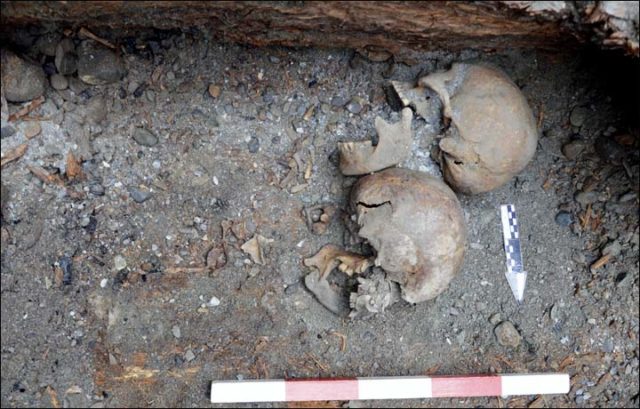Archaeologists have a great job – they get to dig up the remains of ancient artifacts and in the process get to see some truly incredible sights. Pottery, important artifacts from centuries ago, or in some cases even human remains, can really be exciting because, upon further examination, they can reveal a lot about the era from which they came.
Recently, archaeologists were in for a real surprise when they uncovered a burial site from the ancient Pazryk culture. While in the process of the dig to uncover this burial ground, archaeologists were completely baffled by what they saw. There were two skeletons within the tomb; one was an adult, and the other was a child. The initial discovery and investigation did not reveal if the skeletons were male or female as more testing and investigation is required in order for gender to be ascertained. What is most puzzling for the archaeologists involved in this discovery is that the skeletons had had their heads severed and their bodies were covered in fur. This leaves many unanswered questions for the archaeologists and has left them genuinely baffled by the find.

Investigation within the tomb around the skeletons revealed remains of fur garments, as it appears that the dead bodies were sent into the afterlife dressed to ward off the very cold weather of the area of Siberia in which they were buried. Additionally, two bronze mirrors, as well as pieces of a ceramic vase, were found in the nearly two thousand five hundred year old grave. Unfortunately, the grave had been robbed of some of the pieces in previous centuries, so experts have to be content with studying the remaining artifacts.
While scientists are not shocked that the skeletons were headless (this was a fairly common feature of that era), they are surprised by the way in which the skeletons are buried as it is unlike anything that they have ever seen before from the Pazryks, who are considered to have been a culturally advanced group. Scientists do note that burials without heads were fairly common and usually occurred as a result of war. This is because it was a common practice for the heads of defeated enemies to be severed from their bodies and then made into bowls as a means to truly show the victory over the enemy. Then the victors would go a step further and actually eat from the bowls that were made from the skulls of their fallen enemies in a true show of victorious behavior.
But the fact that the skulls were buried with the bodies shows that they were not used in this way. This is what makes this burial site is so unique. In addition, not only were the heads found alongside the bodies, whoever buried these skeletons took great care to ensure that they were properly shielded from the harsh winter that surrounded them, by putting fur over them and ensuring that they were dressed properly.
Scientists are quite perplexed by the placing of the skulls. What is even more confusing is the fact that when this culture buried their own people, they went to great pains not to distort the bodies. In addition, archaeologists say that they have never seen any other burials of children who have had their heads severed.
Archaeologists have posited a theory that the grave robbers who took some of the other artifacts from the grave in the past also severed the heads from the corpses and then placed them alongside the skeletons for reasons that are unknown. It is also worth noting, however, that the skeletons have remained in an anatomical order that would suggest that if the grave robbers did move the heads after the burial, then it must have been very shortly after the death because the ligaments could not have decomposed at the time and still left the skeletons in the shape that they are currently in. Besides trying to figure out how and when it was done, there is also the big question of why. Why would the grave robbers do this? Many scientists are unsure and can only come up with theories that point to motivations including superstition, fear of revenge of the dead, or perhaps a means of humiliating the corpses.

Another theory is that this is the result of some ritual, Siberian Times reported.
We have another story for you:Roman coins discovered buried underneath the ruins of Japanese castle
This is a truly interesting discovery, and hopefully, the scientists involved will be able to find answers to all the questions that this unusual burial has raised.
